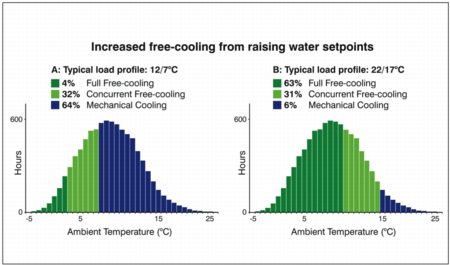Free cooling meets mechanical cooling

Maximising free cooling is one of the keys to reducing the energy consumption of data centres. Mike Peachey explains how Turbocor compressor technology can deliver concurrent free cooling in the same system to achieve huge energy savings.
Free-cooling is essentially what it says on the tin. When a system is operating purely in free-cooling mode, only the fans and pumps are running. However a traditional ‘on/off’ free-cooling chiller may require very low ambient temperatures as low as -3°C, which represents less than 1% of the UK year.
This is not the case for concurrent free-cooling which introduces a mixture of free-cooling and mechanical cooling and which, in a carefully selected system, can deliver partial free-cooling up to 24°C. A concurrent free-cooling system also achieves twice as much free-cooling as an on/off system and saves more than 55% of the energy consumed by a similar sized screw chiller.
Having spent five years developing Turbocor compressor chiller systems with a seasonal energy-efficiency ratio (ESEER) of up to 5.69, Airedale has followed this by applying Turbocor compressor technology and concurrent free-cooling in one system. What makes this system particularly efficient is that these two technologies are designed to work together.
For free-cooling to operate, the difference between ambient and chilled-water return temperatures can be as little as 1 K. When linked with an air-handling unit or rack-mounted unit in a 24/7 data centre with a typical room temperature of 24°C and a cooling requirement of less than 100% which it nearly always is, the ambient temperature needed to satisfy the internal loads can be much higher ,and the chiller can deliver some free-cooling for up to 98% of the year in London.
In a concurrent free-cooling system, free-cooling will always take priority over DX cooling to ensure best system operating efficiency. Smart controls constantly monitor the differences between the outdoor ambient and the room temperature and will only switch on the compressor when extra cooling is needed. Free-cooling potential is maximised both before initiating and during mechanical cooling. Full DX duty in free-cooling alone is achieved at an ambient temperature of 6 K or more lower than a thermo-siphon free-cooling system. In the latter system, concurrent mode is impossible.
During any mechanical cooling, the infinitely variable speed control of the oil-free Turbocor compressor gives exact capacity match and uses substantially less power at part load. The compressor also ensures near-silent operation and has a very low starting current of just 2 A.
The Turbocor compressor can run at a much lower compression ratio than conventional screw compressors — as low as 20ºC condensing temperature when evaporating at 5ºC as opposed to around 35ºC condensing for a screw compressor. This allows the fans to be run faster, maximising free-cooling whilst still maintaining the compressor within its operating envelope during concurrent free-cooling.
A 20% reduction in the compressor shaft speed can reduce input power by 49%, contributing to the compressor having an EER of 10.0 at part load and representing a possible increase in efficiency of 100% compared with conventional screw compressors.

Interactive management of the head-pressure setpoint allows the chiller to decide for itself the best head-pressure setting, minimising total power used by fans and compressor. The addition of a flooded evaporator results in significant energy savings in compressor operation, particularly at part load.
The high efficiency of these chillers makes them ideal for a wide range of air-conditioning applications, particularly in data centres where the high return temperatures will raise the free-cooling threshold.
In a live data centre where a chiller is supplying chilled water to eight air-conditioning units, a very low PUE (power usage effectiveness) of 1.23 when operating in free-cooling mode (which means that for every kilowatt used by the IT equipment, 230 W is used by the support systems, including cooling). Best practice suggests a target PUE of 1.5 to 1.7 for a modern data centre. Power savings in excess of original expectations should enable the PUE to be further improved as more equipment is installed.
From Autumn through to Spring, the chiller in this application uses outdoor ambient air temperature to provide concurrent free cooling. If the ambient temperature reading in the controls sequencer is 1 K or more lower than the common return-water temperature reading in the sequencer for a minimum period of 60 minutes, the free-cooling chiller will be enabled and, if appropriate, become the lead chiller.
Once the return water temperature is within 0.5 K of the ambient air temperature and has remained so for 48 hours continuously, the free-cooling chiller can rotate from being the lead chiller and a standard Turbocor compressor chiller is available to be enabled and become the lead chiller again.
The sequencing control strategy adds to energy efficiency by adjusting variables such as the rate that water is pumped around the cooling system and the speed of the fans in the air conditioning units. The bespoke controls scheme drives and integrates the whole solution to increase resilience, optimise efficiency and put the end user in control of reducing energy costs.
Michael Peachy is product manager with Airedale.








